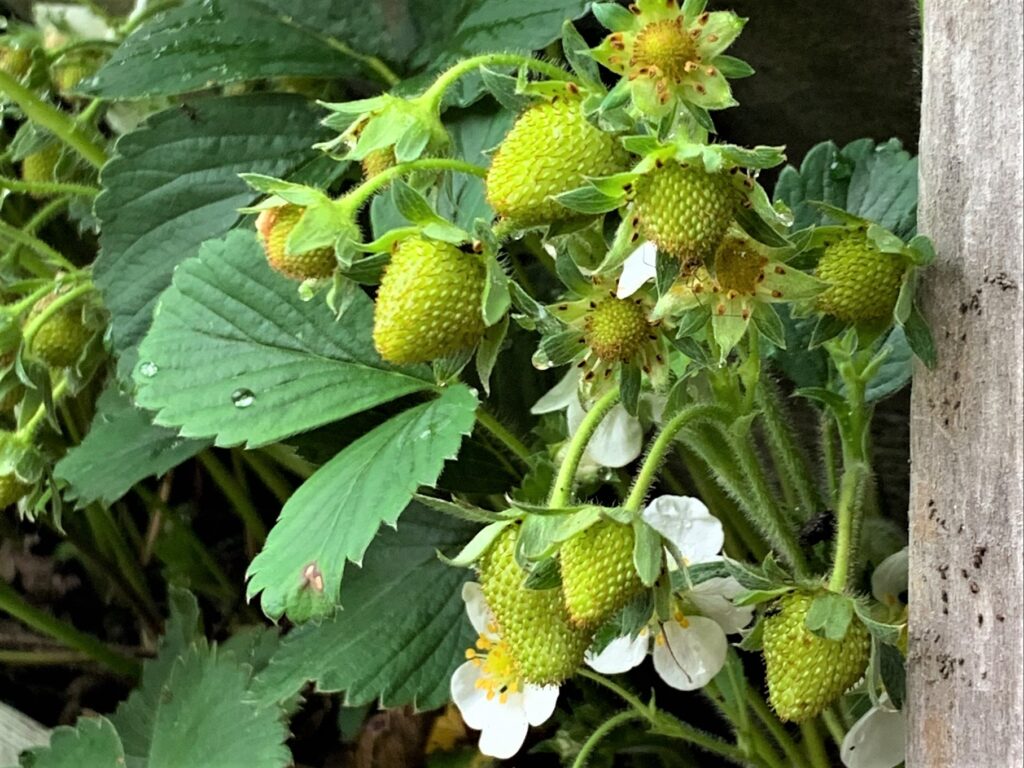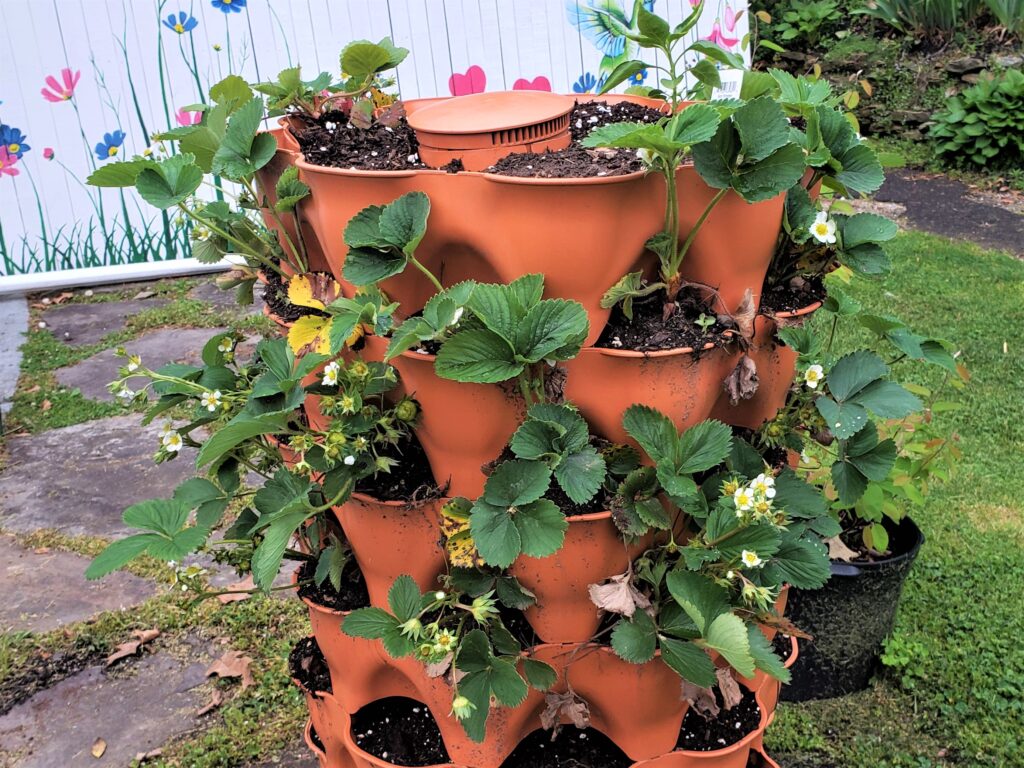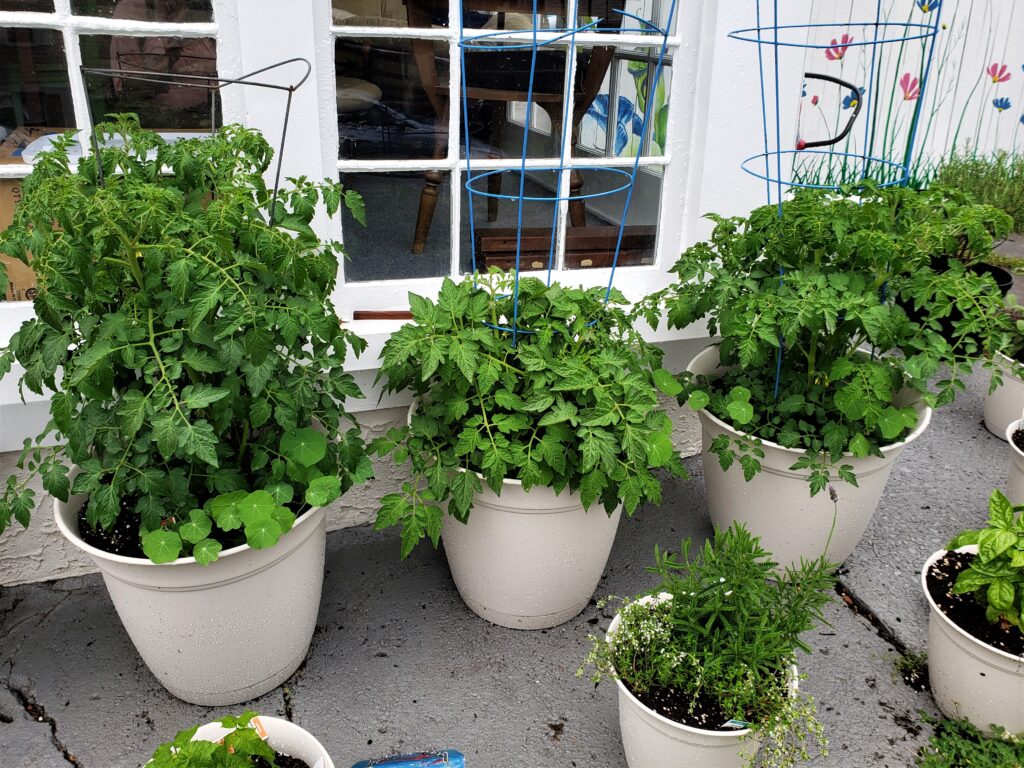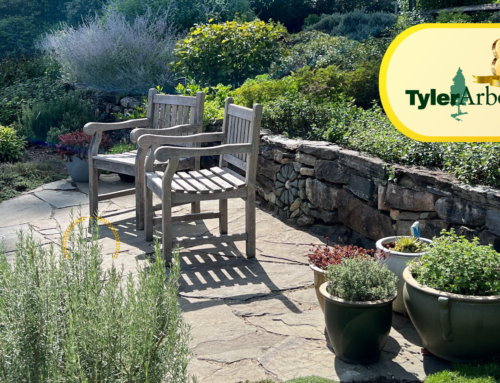It was late April, and we were out of strawberries…again. We go through them faster than ever these days. My son loves them; he’d eat them with every meal if I let him. And he’s taller now; at three years old, he can capably open the refrigerator and take down the carton. So it is normal for me to hear him rustling around in the kitchen and walk in on him sitting on the ground in front of the open fridge with strawberry on his face, surrounded by discarded green leaves.
If I bought them every time we ran out, our grocery bill would be even higher than it already is, which barely seems possible. And the price of everything is still going up. Milk, fresh produce, gas – making a grocery list these days feels like walking a tightrope. Write five items down, cross two off.
We’re pretty resourceful, my partner and I. You really need to be these days, especially as the parents of young children. We’re good at shopping the sales and giving and receiving items in our local Buy Nothing groups. We’ve made an art form of thrifting and never pass by free furniture on the side of the road. But that only gets you so far when gas is nearly $5 a gallon, and milk is pushing $6.
There has to be something more I can do. That’s what I thought to myself as I wandered the aisles of our local Giant, comparing prices on strawberries.
So I asked myself, as I have many times in my life when I’ve needed a solution. What do I know HOW to do? And what do I need to learn?
My background is in environmental restoration, landscape management and native plant horticulture. However, I have always kept a vegetable garden as a hobby. In the days when my partner and I lived in tiny, one-bedroom apartments, I kept herbs in pots and grew tomatoes and peppers in planters on the patio. I started my veggies from seed, trading packets with my friends and sharing our seedlings and soil.
I can grow strawberries, I think to myself.
I set out to do just that. I’d never grown them before; I’ve always lived in areas with plenty of visiting bunnies and deer who would love to take a nibble of the delicious red fruit. And while I like strawberries, they had never occupied such a critical role in my household. So step one would be to figure out how to keep them out of harm’s way – from the wildlife, if not from my toddler.
I had a vertical planter on hand, a birthday gift I had never put to good use, which was perfect because I was short on vegetable planting space. Along with so many other Americans, I had moved in 2021, leaving behind my beloved raised beds. My new yard is shaded and full of deer, rabbits and chipmunks from the nearby wildlife sanctuary. However, I did have a stone patio overlooking our new street, plenty of pots and my vertical planter. I could make it work.
Next, I needed the strawberries. Know your plant and what it needs. That’s the first step of growing a successful garden. These tough native berries don’t ask for much; they can be divided and make do with very little soil to grow in. I picked up a flat of freshly dug-up strawberries at the Tyler Plant Sale and started dividing.
I carefully broke the flat into individual plants and planted my planter, filling each little cell with roots. The flat divided into 30 plants, not a bad value considering it costs about $30. A buck a plant! I thought to myself as I watered them in. Now let’s see what they do.
What they did was grow berries – lots and lots of berries. That’s an astonishing number considering this was their first year in my garden. So far, knock on wood, the deer have stuck to their preferred spots in my yard, eating the hosta, and the vertical planter has kept them out of reach of the rabbits.
It hasn’t kept them out of reach of my son, who has been happily picking and eating them right off the plant.
I also filled my other pots with tomatoes, peppers, herbs and nasturtium. My son is less likely to pick those but likes helping me water. I’ve enjoyed buying fewer strawberries. And since they are a short-lived perennial that spreads via runner, I look forward to seeing what my vertical patch does next year.
Here are my cost-saving tips so far for growing your own strawberry patch:
- Consider a vertical planter! It saves on space without sacrificing berries. You can certainly buy one – or get creative and build your own. A quick Google search will fill your browser with ideas.
- Make your own soil amendments. My planter has a compost tube in the center where I add eggs and vegetable scraps from the kitchen. You can also make your own compost bin out of a trash can or, insider tip, an old Tidy Cat brand litter pail – the tight-fitting lid keeps out wildlife. Just poke a few holes in the top and bottom for drainage, and you’re good to go. I like to place mine in a shallow pan elevated on some old pavers – that way, I can catch the water that drains out to use as compost tea.
- Divide your plants where you can. For example, strawberries spread by runner, so look for the crown of an individual plant and separate it from its neighbors. Plant them with space in between, and in a few years, your patch will fill right back in and be ready to divide again.
However, one thing did surprise me beyond the sheer number of strawberries that grew – and that was the number of neighbors who stopped by to ask about them. I live on a street full of parents of young children. At 5 pm, we open our doors, and the kids run up and down the sidewalk, pushing cars and riding bikes. Exhausted parents of very tiny babies wander behind carrying infants, trying to keep up and mostly failing.
The kids all stopped by to see the strawberries. They were fascinated by how they started as starry white flowers and turned to hard green berries, and when those berries ripened to red, they recognized them as a beloved snack.
I watched my son, so proud of his berry patch, share with his friends. He would pick the berries carefully, one at a time. This one is for Quentin; this one is for Cole, he’d tell me, handing them out.
We had plenty to give away, and watching my three-year-old do so with abandon was a good reminder that food should be shared. This is how we are meant to live, as a community of people coming together to support one another.
It inspired me to do the same. So I told my neighbors to stop by for herbs, if they needed them. I let them know that I had seeded collards into the bottom of the strawberry tower and that I would make sure to tell them when the tomatoes came in.
Sharing with open hands builds a bridge. One neighbor dropped off some squash seedlings they had to share. Another offered hand-me-down crib sheets and blankets in preparation for our second little one, who will be born in August. As the days heat up, we all gather to let the kids play in one another’s splash pools while we cook dinner. I’m not sure I can credit the strawberry patch for everything. People want community. Sometimes, it can be hard to find it in a world where we exist so much online. But, sometimes, all it takes is one red berry. It turns out it’s much less scary to face rising costs and an increasingly chaotic world when you know you aren’t alone, when you can step outside your door and connect with other people who know exactly how you are feeling.
Strawberry season is ending – but now I have a goal that stretches beyond a few weeks in May and June. We live in difficult times. It’s easy to lie awake at night wondering how you’ll be able to provide for your family or even keep them safe in a world of rising costs, violence, and a global pandemic that just won’t quit.
However, maybe resilience isn’t as far away as it seems. Perhaps the secret is remembering things we’ve known for thousands of years – how to be creative and innovative with the resources we have on hand, how to grow our own food and share that food with our neighbors, and how to come together as a community to support one another.
That will be my goal for this summer – and beyond; to grow that resilience. I’ll dig deep and learn more about how to garden on a budget, reduce the cost of the weekly trips to the grocery store, and not just for me, but my community as a whole, online and in person.
Stay tuned. As the year goes on I’ll share resources, tips and tricks. These may be difficult times. But we don’t have to do it alone. Together we can share what we know and what we’ve learned. Together we can grow a brighter and more resilient future.









